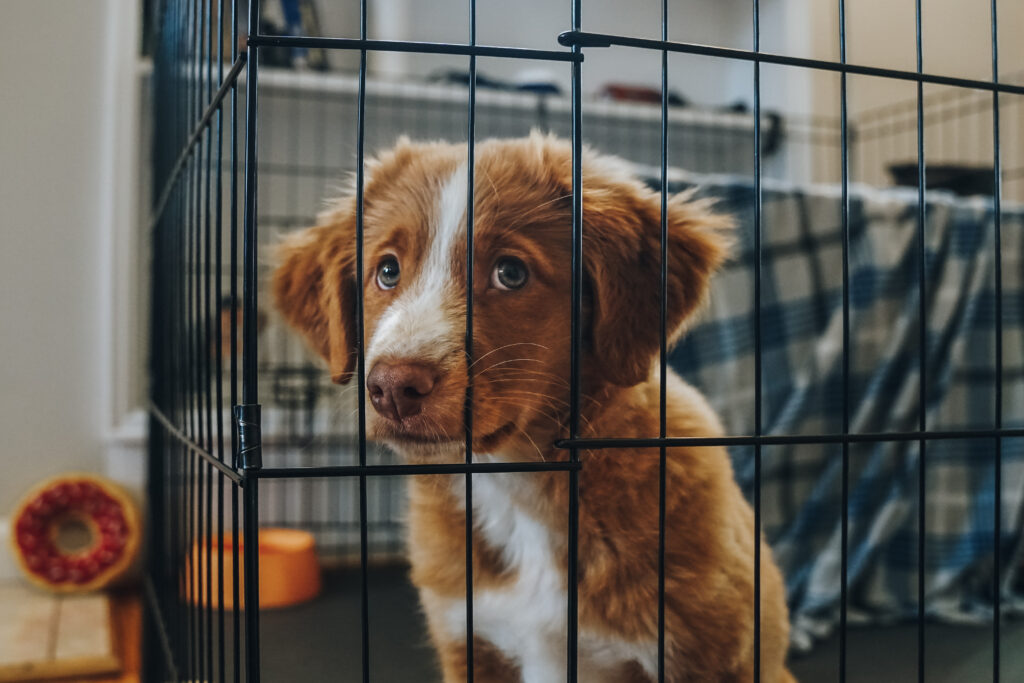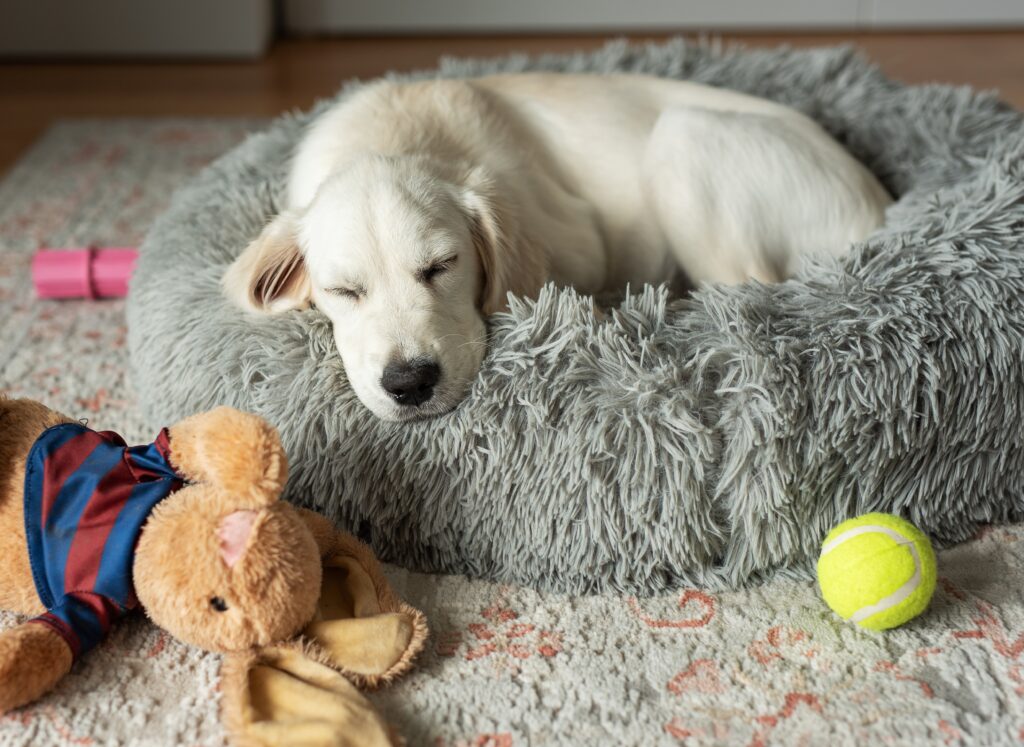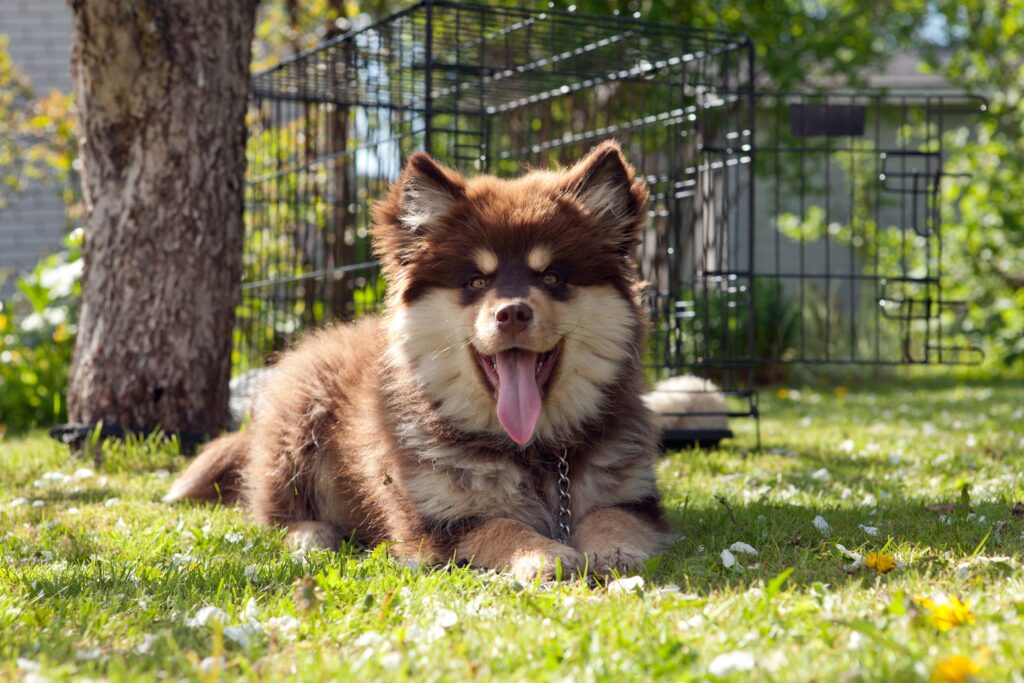It’s normal for an 8-week-old puppy to cry when placed in a crate, especially in the beginning. It’s important to strike a balance between providing reassurance and ensuring that you don’t reinforce undesirable behavior.
Here’s how to handle your puppy’s crying in the crate…
Understanding Why Puppies Cry in the Crate
- Separation Anxiety
- Puppies at this age are used to being with their littermates or mother. Being alone in a crate is new and may cause them to cry or whine for attention.
- Adjustment to New Environment
- The crate might feel unfamiliar or scary at first, contributing to their stress or crying.
- Need to Go Potty
- If they are crated too long, especially for the first time, they may need a potty break and will cry to let you know.
- Boredom or Energy
- Puppies have a lot of energy. If they haven’t had enough exercise during the day or right before crate time, they may cry out of frustration.
How Long to Let Your Puppy Cry in the Crate
- Initial Adjustment Period (First Few Nights)
- It’s expected that your puppy will cry for a while during the first few nights, as they adjust to the crate and being away from their litter.
- Gradual Crying Reduction
Over time, they should settle as they get used to the environment, and the crying will naturally decrease. Typically, a puppy might cry for 10–20 minutes when placed in the crate at first. This can gradually lessen as they become accustomed to the crate.
- Don’t Let the Crying Continue Forever
- If the crying persists beyond 20-30 minutes (or becomes excessive), consider checking if something might be wrong (e.g., hunger, needing the potty, discomfort).
- Provide Comfort and Reassurance – If you’ve gone through the basics (potty break, food, water, a toy), and your puppy continues to cry, offer calm reassurance but don’t reward the crying with attention or let them out immediately. Responding to the cries by opening the crate will reinforce the idea that whining results in freedom.
- Avoid “Too Long”
- You shouldn’t leave a crying puppy in the crate for an extended period of time (over an hour) if they continue to cry without settling. You should consider whether they need more exercise, bathroom breaks, or reassurance before leaving them alone again.
Steps to Help Your Puppy Settle in the Crate
- Positive Associations
- Reward calm behavior – Reward them with praise, treats, or a toy when they’re quiet or lying down in the crate. Positive reinforcement helps associate the crate with good things.
- Comfort items – Put in a comfortable bed or blanket and something with your scent (like an old t-shirt) to help them feel secure.
- Crate Training – Start with short crate sessions during the day and gradually increase the duration. This will help your puppy associate the crate with safety and relaxation.
- Potty Breaks
- Before putting your puppy in the crate, make sure they’ve had a good potty break.
- If they cry and you suspect they need to go, immediately take them outside to avoid any accidents.
- Create a Routine
- Puppies thrive on routine. Establish a consistent pre-bedtime routine (like a potty break, some playtime, and then crate time), which helps your puppy feel secure.
- Gradual Time in the Crate
- Over time, increase the amount of time they spend in the crate to help them get used to it. Start with 10-20 minutes, then gradually increase, giving them breaks to go potty and get exercise.
Should You Let Your Puppy Cry It Out?
Letting your puppy cry it out is controversial, and it’s up to you how much you can tolerate. Some trainers suggest briefly ignoring the crying to teach your puppy to self-soothe and settle on their own. This should be balanced with…
- Checking if they really need something.
- Ensuring that their basic needs are met (like hunger, water, and bathroom).
- Not punishing or harshly reprimanding your puppy for crying.
Things to Keep in Mind
- Crying can be a sign of discomfort
- If your puppy cries longer than expected, check if something is causing them distress (e.g., being too hot or cold in the crate, discomfort with bedding).
- Avoid Negative Associations
- Don’t associate the crate with punishment. This should be a safe and comforting space.
- Gradually Increasing Alone Time
- As your puppy matures and learns that their crate is a safe, pleasant space, they should cry less. At 12-16 weeks old, puppies are better able to handle longer periods of alone time in the crate at night.
Allow your 8-week-old puppy to cry for short periods when first using the crate. They may cry for up to 20–30 minutes as they adjust. Be sure that basic needs (such as bathroom breaks) are met. Don’t reward crying by letting them out, but comfort them through gradual training, creating a positive environment, and ensuring their crate is a safe, pleasant space.


